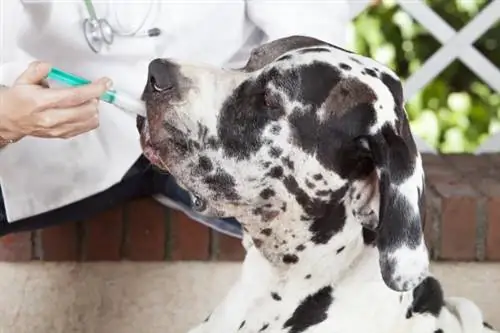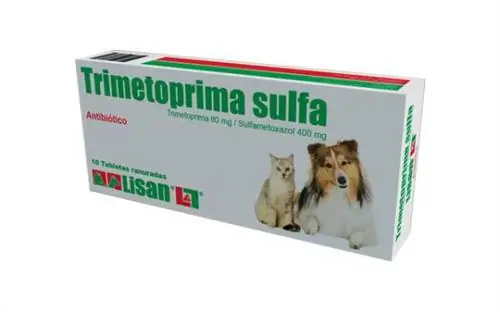- Author Carl Johnson [email protected].
- Public 2023-12-16 06:19.
- Last modified 2025-01-23 08:59.

Pediatric septrin is an antibiotic that contains two different active ingredients: trimethoprim and sulfamethoxazole. The combination of these two antimicrobial compounds has a synergistic potentiation effect, making septrin an effective drug for the treatment of multiple systemic infections. Like any other medication, remember that it should only be administered under veterinary prescription.
What is pediatric septrin?
Pediatric septrin is an antibiotic drug that combines two active ingredients: the trimethoprim and sulfamethoxazole Although it is a medicine specially designed for use in people, specifically in children, it can also be used in dogs. In fact, there are several similar veterinary drugs that also combine trimethoprim with sulfonamides such as sulfadiazine.
Both trimethoprim and sulfamethoxazole act by inhibiting bacterial DNA synthesis, although each compound acts at a different level. Specifically, trimethoprim inhibits the enzyme dihydrofolate reductase, while sulfamethoxazole acts by inhibiting dihydropteroate synthase. The combination of both antibiotics has a bactericidal effect, that is, they cause the death of bacteria.
The reason these two active ingredients are combined is because together they have a synergistic potentiation effect, which means that in Together they produce a markedly superior response to that which would be obtained with the two compounds separately. In fact, it is known that when both principles are combined, their action is effective on 40% of bacteria that could be resistant to any of the components separately.
Introducing the pediatric septrin
Pediatric septrin is currently available as tablets and oral suspension However, veterinary drugs containing the same principles active than pediatric septrin are also available as a solution for injection for intramuscular, intravenous, and subcutaneous administration.
In any case, you must remember that the administration of this and any other drug should only be done under veterinary prescriptionThe indiscriminate use of antibiotics leads to the appearance of bacterial strains resistant to antibiotics and, as a consequence, to a dangerous decrease in the effectiveness of antimicrobial treatments. Therefore, they should only be used when necessary and after making a proper risk/benefit assessment.

What is pediatric septrin used for in dogs?
Knowing that septrin is an antibiotic, you may be wondering what pediatric septrin cures.
Generally, this broad-spectrum antibiotic is used for the treatment of systemic infections (respiratory, digestive, genitourinary, dermatological, etc.) caused by:
- Gram negative bacteria.
- Aerobic gram positive bacteria. It should be noted that it is the treatment of first choice for Nocardia infections.
- Some protozoa, such as Toxoplasma.
Pediatric Septrin Dosage for Dogs
As we have already mentioned, pediatric septrin is only available in the form of tablets and oral solution, so it can only be administered orally. Specifically, the dose of septrin per kilo of weight in dogs is 15- 25 mg per kg of weight, every 12 hours Usually, 5-day treatments are scheduled.
Once we know the oral dose of septrin, we need to explain how to give septrin to dogs:
- Septrin pediatric 20 mg/100 mg tablets: one tablet should be administered for every 5 kg of weight, every 12 hours. To prevent your dog from spitting out the tablet, try to get it into his mouth as far as you can, then keep his mouth closed while gently massaging his throat until he swallows. If this method is not effective, you can choose to hide the tablet in a treat or crush it and mix it with a small amount of food.
- Pediatric septrin 8 mg/40mg/ml oral solution: 1 ml should be administered for every 2 kg of weight, every 12 hours. Once you have loaded the oral solution into a syringe without a needle, you should lift the lip, introduce the syringe behind the fangs and slowly deposit the contents into the oral cavity.
Pediatric septrin side effects in dogs
The administration of pediatric septrin in dogs can cause the appearance of:
- Hematopoietic alterations: that is, alterations in the synthesis of the different cellular components of the blood.
- Alterations in the kidney and urinary tract: such as renal obstruction, crystalluria (presence of crystals in the urine) and hematuria (presence of blood in the urine).
To avoid renal deterioration due to crystal formation, it must be ensured that the animal remains well hydrated during treatment with septrin. For this, it is essential that you always have fresh and clean water freely available.
Contraindications of pediatric septrin in dogs
Although pediatric septrin is a very effective drug for the treatment of multiple systemic infections, there are a number of situations in which its administration can be counterproductive in dogs.
Specifically, the contraindications for pediatric septrin in dogs are as follows:
- Allergy or hypersensitivity to trimethoprim, sulfamethoxazole or any of the excipients contained in the drug.
- Severe liver or kidney damage.
- Dehydration.
- Alteration in blood cells (red blood cells, white blood cells and/or platelets), both due to excess and deficiency.
- Treatments with para-aminobenzoic acid (PABA).
- Oral anticoagulant therapy.
- Treatments with urinary acidifiers.
Again, it is important that we insist that you should not administer pediatric septrin to your dog without the prior authorization of the veterinarian, since you could worsen his situation.






